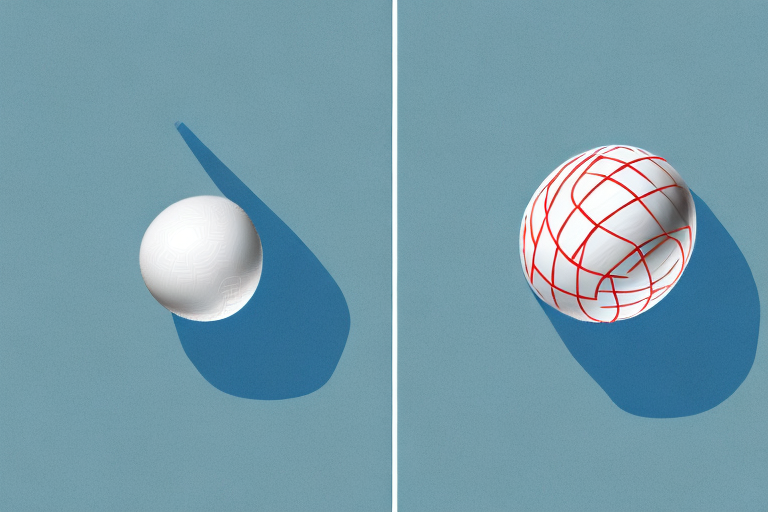If you’re looking to relieve muscle tension and improve mobility, you might have heard of myofascial release. This technique involves applying pressure to trigger points or “knots” in the muscles and fascia tissue surrounding them. Two popular tools for myofascial release are the trigger point ball and lacrosse ball. But which one is better? In this article, we’ll compare the two and help you decide which one is right for you.
Understanding Myofascial Release and Its Benefits
Myofascial release is a technique that targets the fascia tissue, which surrounds and stabilizes muscles and organs in the body. When fascia becomes tight or restricted, it can cause muscle knots or trigger points. Myofascial release helps to release these knots, improving circulation, flexibility, and range of motion. It may also help reduce pain and tension in the muscles.
Myofascial release can be performed by a trained therapist or through self-massage techniques using foam rollers or massage balls. It is often used as a complementary therapy for conditions such as fibromyalgia, chronic fatigue syndrome, and sports injuries. While myofascial release can be uncomfortable during the treatment, many people report feeling relaxed and rejuvenated afterwards. It is important to consult with a healthcare professional before trying myofascial release, especially if you have any underlying medical conditions.
The Purpose of Using Trigger Point and Lacrosse Balls for Myofascial Release
Trigger point balls and lacrosse balls are both used for myofascial release by applying direct pressure to trigger points in the body. They are affordable and portable, making them a convenient option for home use. These tools can help improve circulation and flexibility in the muscles while reducing pain and tension.
In addition to their physical benefits, using trigger point and lacrosse balls for myofascial release can also have mental health benefits. The act of applying pressure to trigger points can be a form of self-massage and can promote relaxation and stress relief. This can be especially helpful for individuals who experience tension and stress in their daily lives.
Anatomy of Trigger Point Balls and Lacrosse Balls
Trigger point balls are typically smaller and made of dense foam or rubber. They are designed to target specific areas of the body, such as the shoulders, neck, and feet. Lacrosse balls, on the other hand, are larger and made of hard rubber. They are commonly used for larger areas of the body, such as the back and hips. Both types of balls can be effective for myofascial release, but the size and material may be better suited for different needs.
It is important to note that while trigger point balls and lacrosse balls can be effective tools for self-massage and myofascial release, they should be used with caution. Applying too much pressure or using them on sensitive areas can cause discomfort or even injury. It is recommended to start with gentle pressure and gradually increase as needed, and to avoid using them on areas with injuries or inflammation. It is also important to consult with a healthcare professional before using these tools, especially if you have any underlying medical conditions.
How to Choose the Right Size for Your Trigger Point or Lacrosse Ball
Choosing the right size ball depends on the area of the body you want to target. Trigger point balls are typically smaller, ranging from 1.5 inches to 3 inches in diameter. Lacrosse balls are larger, typically around 2.5 inches in diameter. It’s important to choose a ball that is appropriate for the area you want to target. For example, a larger ball may work better on the back, while a smaller ball may be easier to use on the feet or hands.
Another factor to consider when choosing the right size ball is your level of experience with trigger point or lacrosse ball massage. If you are new to this type of therapy, it may be best to start with a smaller ball and gradually work your way up to a larger size as your muscles become more accustomed to the pressure. Additionally, if you have a specific injury or condition, it’s important to consult with a healthcare professional before using a trigger point or lacrosse ball to ensure that you are using the appropriate size and technique for your individual needs.
The Pros and Cons of Using Trigger Point Balls for Myofascial Release
One benefit of using trigger point balls is their smaller size, which allows for greater precision in targeting specific areas. They can be used to apply pressure to hard-to-reach areas such as between the shoulder blades or under the foot. Foam trigger point balls are also softer and gentler on the skin than lacrosse balls. The downside to trigger point balls is that they may not be as effective for larger areas of the body, such as the back or hips.
The Pros and Cons of Using Lacrosse Balls for Myofascial Release
Lacrosse balls are larger and firmer than trigger point balls, making them more effective at applying deep pressure to larger areas of the body. They can be used on the back, hips, and legs to relieve tension and improve mobility. However, they may be too big or uncomfortable for smaller areas such as the feet or hands. Lacrosse balls may also be harder on the skin and cause bruising or discomfort if used incorrectly.
Which Type of Ball is Best for Specific Areas of the Body
The size and material of the ball determine which areas of the body are best targeted. Trigger point balls are ideal for massaging small or hard-to-reach areas such as the neck, shoulders, and feet. Lacrosse balls are better for larger areas such as the back, hips, and legs. However, it’s important to choose a ball that is comfortable and easy to use, regardless of the area of the body.
Tips and Techniques for Effective Myofascial Release with Trigger Point and Lacrosse Balls
When using trigger point or lacrosse balls for myofascial release, it’s important to start slowly and apply gentle pressure. Gradually increase the pressure as your muscles begin to loosen up. Remember to breathe deeply and relax your muscles as you massage them. You can also try different techniques such as rolling, pressing, or pinning the ball to release tension in different areas.
Combining Trigger Point and Lacrosse Balls in Your Myofascial Release Routine
If you’re unsure which ball to use, you can experiment with both trigger point and lacrosse balls to find what feels best for you. Combining the two can also provide a more well-rounded myofascial release routine. For example, you can use trigger point balls on smaller areas such as the hands and feet, and lacrosse balls on larger areas such as the back and hips.
Safe Practices and Precautions When Using Trigger Point and Lacrosse Balls
It’s important to use caution when using trigger point and lacrosse balls for myofascial release. Avoid using too much pressure or leaving the ball in one spot for too long, as this can cause discomfort or bruising. If you have a pre-existing condition or injury, consult with a healthcare professional before using these tools. Always listen to your body and stop if you experience pain or discomfort.
Conclusion: Choosing the Best Option for Your Myofascial Release Needs
When it comes to choosing between trigger point balls and lacrosse balls for myofascial release, it ultimately comes down to personal preference and the area of the body you want to target. Trigger point balls are smaller and gentler, making them better for smaller or hard-to-reach areas. Lacrosse balls are larger and firmer, making them effective for larger areas such as the back and hips. Regardless of which ball you choose, using proper technique and caution is key to a safe and effective myofascial release routine.





